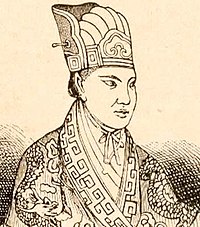Politics of Orioni
Politics of Orioni Erwaniye poletika | |
|---|---|
 Seal of Orioni | |
| Polity type | Unitary parliamentary constitutional monarchy |
| Constitution | Constitution of Orioni |
| Legislative branch | |
| Name | Sibiseba |
| Type | Unicameral |
| Appointer | Direct election |
| Executive branch | |
| Head of State | |
| Title | Empress |
| Currently | Joni I Nabérrie |
| Head of Government | |
| Title | Chairlady |
| Currently | Chandra Pristo |
| Cabinet | |
| Name | Imperial Council |
| Current cabinet | Pristo II |
| Ministries | 12 |
| Judicial branch | |
| Name | Judiciary of Orioni |
The politics of Orioni take place with the framework of a parliamentary democracy under a constitutional monarchy in which the monarch, currently Empress Joni, is the head of state while the Chairperson of the Memakiriti, currently Chandra Pristo, is the head of government. The Orinese Constitution provides for a separation of powers. The political system of Orioni consists of an executive branch, a legislative branch, and a judicial branch.
Executive power is exercised by the Chairperson of the Imperial Council (Oharic: Memakiriti). The Government consists of the Chairperson and councillors. The government, including the Chairperson, can be revoked by the Sibiseba.
The Sibiseba (Anglish: Assembly) passes statutes and votes on the budget; it controls the action of the executive through formal questioning on the floor of the houses of Sibiseba and by establishing commissions of inquiry. The Orinese political system is a multi-party system. Former executive leaders are members of the Sibiseba.
The judiciary is based upon civil law system and is independent of the executive and the legislature. The highest court is the Imperial Court of Orioni.
History
An early executive branch was the Imperial Council (Oharic: Memakiriti). At its creation in 1175, it was composed of four councillors or advisors, with the monarch representiving the fifth decisive vote. Each councillor was the head of a specialized department and a geographical area of expertise (several provinces). The Empress would open her personal correspondence and discuss hearings only in the presence of at least 2 councillors. They gave council to the empress, and countersigned (or co-signed) and expedited royal decisions (edicts and declarations). The four departments were:
- Councillor for Foreign Affairs: oversaw diplomacy and trade.
- Councillor for War: oversaw border provinces.
- Councillor for the Navy: oversaw colonial matters.
- Councillor of the Imperial Household: oversaw the royal entourage, personal military guard, clergy, affairs of the capital, and royal buildings.
The Council was considered a very important body of government. The various councillors were still subject to the crown. Some historians even consider it to be more important than the Monarchy itself.
In 1195 new laws were introduced to celebrate 20 years of restoration. An early legislative branch was formed as part of the constitutional law reforms, transforming the monarchy into a more deliberative form. The Gizatochi was an early precursor to the Sibiseba. This institutionalised assembly critiqued monarchical decisions, discussed laws about taxes, trade, diplomacy, and military matters. It was a select committee that included fifty noble representatives from the Tamanyi cities. This was expanded in later centuries to include representatives from. However, colonial posessions were not represented.
Monarchy
National government
Executive
Legislative
Judicial
Weekly agenda
- Monday: review of legislative by judicial
- Tuesday: Sibiseba meets
- Wednesday: Memakiriti meets
- Thursday: Subcouncils meet
- Friday: Question time of executive by legislative
Local government
Political parties and elections
Types
Alliances
Policy making
Foreign Relations
This template may be deleted.

